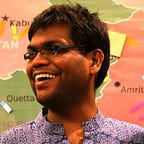Genders without Borders
(This book review was first published in Business Standard.)
We are in the middle of a rapidly changing discourse around gender and sexuality. Old definitions appear narrow. New vocabularies seem out of reach. The truth of the matter is that multiple realities, often incompatible at first sight, coexist in our present. Journalist Mark Gevisser, based in South Africa, does some excellent stock-taking with his book The Pink Line: Journeys Across the World’s Queer Frontiers (2020) published by HarperCollins India.
He writes, “The notion of LGBT rights was spreading globally at the exact moment that old boundaries were collapsing in the era of globalization. The collapse of these boundaries meant the rapid global spread of ideas about sexual equality or gender transition — and, at the very same time, a dramatic reaction by conservative forces, by patriarchs and priests, who feared the inevitable loss of control that this process threatened.” The second decade of the 21st century is the time frame he is looking at.
This book is packed with information about political developments in different continents and nuggets from queer scholarship but it is also a collection of personal stories told with respect, care and accountability. The lives of the protagonists these stories are built around are filled with tough choices. The whole point of engaging with them is to appreciate the context within which certain decisions are made; not to peek in from a moral high ground.
“These people drive their own stories; the rest of us — activists and policymakers, scholars and scribes and readers — try to catch up,” writes Gevisser, a white gay man who is deeply reflective about power dynamics between the researcher and the researched. This is not a performative act of political correctness but a rich perspective on the ethics of collecting data from marginalized populations and prioritizing questions of safety, consent and rights throughout the process. These relationships play a big role in shaping the knowledge available to readers.
Gevisser notes, “I have done my best to use the language the people I write about feel most comfortable with. I describe Liam as a straight transgender man because this is how he describes himself…If Pasha calls herself transgender, that’s what I call her; if Charlotte calls herself a transsexual, ditto.” Gevisser follows the principle of self-determination, which involves honouring people’s understanding of who they are, how they wish to be addressed, and the pronouns they go by.
For people unfamiliar with this way of interacting, the effort might seem too much to make. Gevisser doesn’t dismiss them outright. He explains, “There are words or phrases you might not be familiar with: cisgender, gender congruent, assigned gender at birth. Is it sex change surgery, gender reassignment surgery, gender affirmation surgery, or gender confirmation surgery? These are shifting sands, as the lexicon of a long-misunderstood group of people establishes itself as common usage, outside of the pathologizing discourse of medicine.”
Language is one of the means individuals and communities use to heal from the wounds of their history. The brilliance of this book lies in recognizing that, while also enquiring into how queer lives acquire meaning through human rights discourse crafted via the NGO industrial complex, university departments, the diversity and inclusion agenda of corporate houses, and government mandates to earn from pink tourism. On the one hand, there is eagerness to lap up international funding; on the other hand, there is stiff opposition against Western hegemony.
Gevisser writes, “Starting in 2007, Mexico City’s crusading progressive mayor, Marcelo Ebrard Casaubon, had used startling new laws legalizing abortion and same-sex marriage in order to attract young and forward-looking people — and pink-dollar tourists — to the metropole, brading his city La Ciudad de las Libertades, the City of Freedoms.” Buenos Aires, Istanbul, Cairo, Beirut, Tel Aviv and Bangkok are other examples he uses to discuss the role of cities in nourishing queer identities. Is it a temporary escape, or a promise of a new life? The book leaves that question for readers to mull over.
Queer migration is another theme explored here with sensitivity. Though the UN Refugee Convention is applicable to “LGBT individuals” with “a well-founded fear of being persecuted,” queer asylum seekers face violence from authorities. Gevisser reveals some shocking facts. “Some countries, like the Czech Republic, were accused of conducting invasive sexual arousal tests on asylum applicants,” he writes. Last year, a UK immigration judge rejected a gay man’s asylum claim because he did not wear lipstick or come across as effeminate.
Indians might enjoy reading Gevisser’s analysis of how ‘kothi’ as an identity category developed “partly on the wings of the fight against AIDS…particularly among poor and rural people — in a way that rivaled the boom of a middle-class gay scene in the cities.” During his fieldwork in Tamil Nadu, a participant said, “Gays wear nice clothes and have parties and sex. A kothi is someone who lives in the village and does women’s work.” Are queer communities in India ready to engage sincerely with questions of caste and class? Only time will tell.
